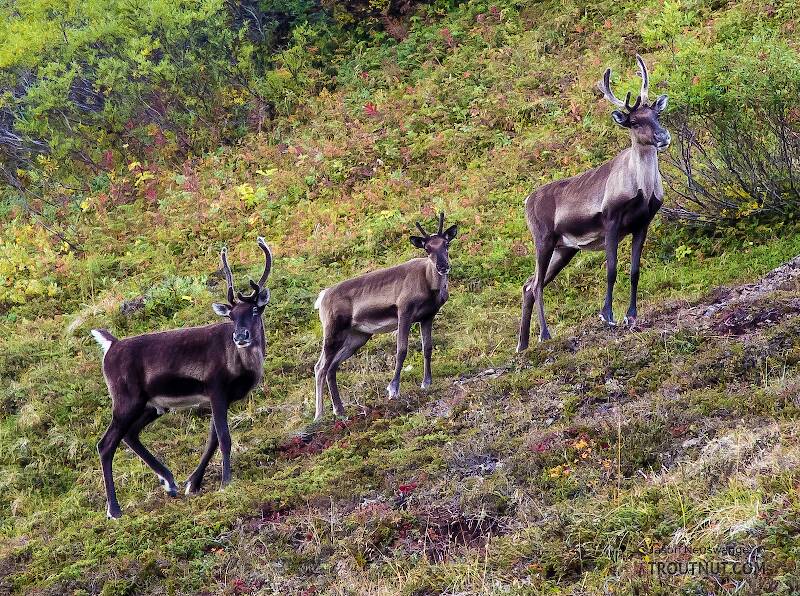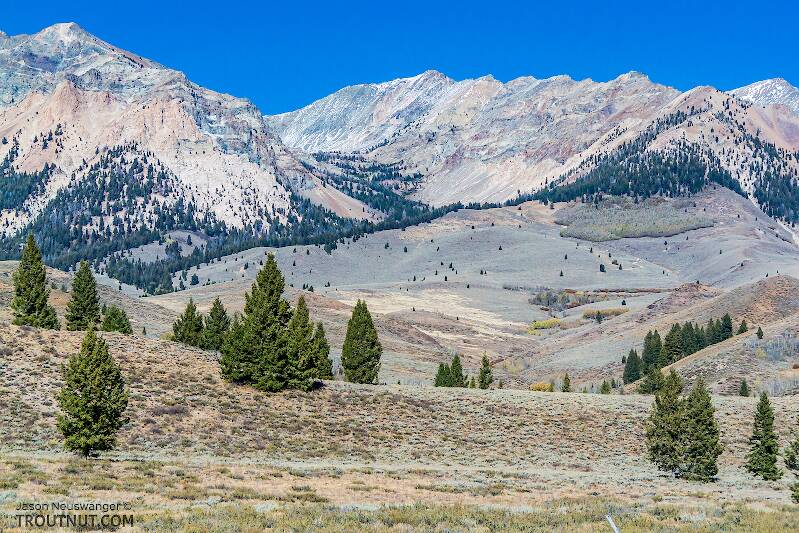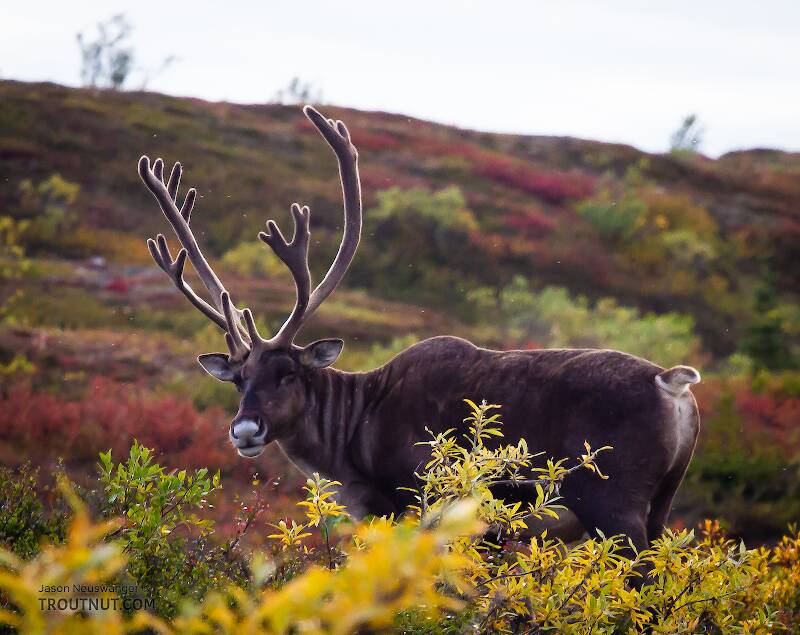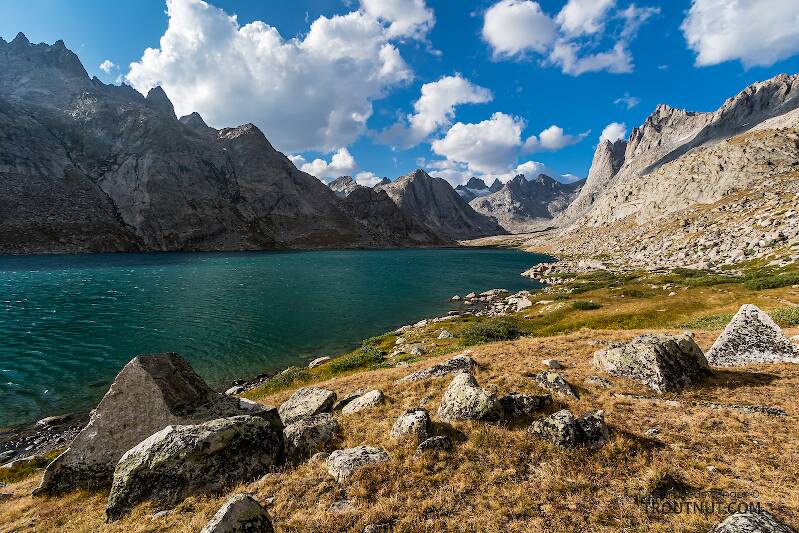See Jason's account of Day One for photos.
After arriving late from Fairbanks, Jason and I spent a quiet, comfortable night last night in the "Lake Cabin" at the McLaren River Lodge (Mile 42 on the Denali Highway).
We awoke to the sound of light rain outside the cabin. We dressed casually, had a hearty breakfast in the nicely appointed restaurant and lodge, then geared up for a long day of backpacking through both lowland and alpine tundra. My new, breathable Kuiu Chugach NX rain pant and jacket would hopefully keep me dry in the intermittent light rain while trekking through dense, wet vegetation. I hoped the new “Sport Slick” gel I applied to my right heel would work as advertised to prevent a blister in that traditional trouble spot. I also stretched my lower back thoroughly for the last time, hoping to prevent debilitating muscle spasms while carrying a 70-pound backpack up and down mountain slopes far from any road. I suppose I should be grateful to have such relatively minor health concerns at the age of 59, but they are annoying nonetheless. I was determined to do what I could before I no longer can.
We headed west on the Denali Highway around mid-morning and stopped at a parking area near the bridge over Clearwater Creek to take advantage of an enclosed privy in the rain, then inspected the creek—our proposed take-out point—from the bridge. After looking apprehensively at the “Class 1” (equivalent to class 2-3 in Wisconsin) rapids and considering all possible locations for landing our rafts at the end of our float out, we chained Jason’s mountain bike to a bridge abutment and headed west several miles to the informal “trail head” of our expedition along the road. Packs loaded and trekking poles in hand, we left the RAV4 behind and headed north into the non-motorized backcountry at about 11:00 a.m.
It felt good to be back in this rugged but beautiful country. Some of the dwarf birch and blueberries were already turning orange or purplish red, though the tundra was not yet in its full autumn glory. We trekked at a steady pace, but stopped frequently to hydrate and look around for caribou and other wildlife. A few small groups of caribou cows and calves were spotted – some at fairly close range – but no obvious bulls. Still, the mere presence of animals was encouraging.
Because my retirement and this trip to Alaska had not been planned far in advance, I spent only a week on physical conditioning while still in Wisconsin. Carrying a 50-pound pack on wide, fairly level trails does not fully prepare one to carry 70 pounds through thick brush over hummocks, up and down steep slopes, and across streams. What helped more than anything is the fact that my wife, Sandy, had started me on a low-carb, high-fat, “ketogenic” diet several months before. I had already lost over 20 pounds of useless fat; but more importantly, my metabolism had converted to a more sustainable source of cellular energy (fats converted at a steady rate to ketones), no longer relying on frequent short-term bursts of glucose from carbohydrates. Endurance athletes are increasingly switching to this diet, and now I understand why. Though the hike was challenging, we passed the base camp we had used last year by late afternoon; and I made it approximately 6 miles before fatigue and impending darkness suggested it would be prudent to make camp for the night. Even Jason was ready to rest by 8 p.m. The entire day, my lower back accepted and even seemed to welcome the weight of the pack on my hips. Remarkably, it felt better at the end of the day than at the beginning.
Despite the quality of our high-tech clothing and rain gear, the combination of constant moisture on the outside and sweat from the inside had soaked us by the time camp was made. Air temperature was falling quickly, and I spent a few chilly minutes in the tent stripping out of wet clothes and into something dry before heating up some Mountain House meals for supper and crawling into my sleeping bag for the night. It rained off and on all night, but I slept like a rock.

Hex Mayflies
Hexagenia limbata
The famous nocturnal Hex hatch of the Midwest (and a few other lucky locations) stirs to the surface mythically large brown trout that only touch streamers for the rest of the year.
Featured on the forum

This species was fairly abundant in a February sample of the upper Yakima.

Troutnut is a project started in 2003 by salmonid ecologist Jason "Troutnut" Neuswanger to help anglers and
fly tyers unabashedly embrace the entomological side of the sport. Learn more about Troutnut or
support the project for an enhanced experience here.
2014 Caribou Hunt - Dad's account
2014 Caribou Hunt - Dad's account
In this article
More Hunting Trip Reports

2014 Alaska Range Caribou Hunt with Dad
This year my dad accompanied me on my annual caribou hunt, and we found more adventure than intended.
We both kept journals during the trip. Anyone interested can read the story from Dad's perspective, too.

Chasing Mule Deer in Idaho 2019
Having struck out on mule deer two years in a row in Washington, I tried neighboring Idaho to continue my climb up the mule deer learning curve for 2019.

2012 Alaska Range Caribou Hunt
I backpacked several miles off the Denali Highway in the heart of the Alaska Range, searching for a bull caribou during the peak of the area's scenic majesty.

